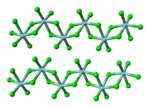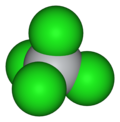Zirconium(III) bromide is an inorganic compound with the formula ZrBr3. Almost all the trihalides of titanium, zirconium and hafnium can be prepared by...
5 KB (320 words) - 21:24, 21 December 2022
Zirconium bromide may refer to: Zirconium(IV) bromide (zirconium tetrabromide), ZrBr4 Zirconium(III) bromide (zirconium tribromide), ZrBr3 This set index...
496 bytes (51 words) - 19:46, 20 December 2023
Zirconium(IV) bromide is the inorganic compound with the formula ZrBr4. This colourless solid is the principal precursor to other Zr–Br compounds. ZrBr4...
4 KB (313 words) - 11:52, 20 January 2024
Zirconium(III) iodide is an inorganic compound with the formula ZrI3. Like other group 4 trihalides, zirconium(III) iodide can be prepared from zirconium(IV)...
6 KB (399 words) - 21:57, 21 December 2022
Zirconium(III) chloride is an inorganic compound with formula ZrCl3. It is a blue-black solid that is highly sensitive to air. The material was first...
6 KB (413 words) - 21:31, 21 December 2022
silicide – ZrSi2 Zirconium(IV) silicate – ZrSiO4 Zirconium(IV) fluoride – ZrF4 Zirconium(IV) bromide – ZrBr4 Zirconium(IV) iodide – ZrI4 Zirconium(IV) hydroxide...
119 KB (8,735 words) - 18:51, 11 November 2024
7779–90–0 ZrBr3 zirconium(III) bromide 24621–18–9 ZrBr4 zirconium(IV) bromide 13777–25–8 ZrC zirconium(IV) carbide 12070–14–3 ZrCl2 zirconium(II) chloride...
139 KB (120 words) - 17:07, 15 July 2024
Zirconium(IV) chloride, also known as zirconium tetrachloride, (ZrCl4) is an inorganic compound frequently used as a precursor to other compounds of zirconium...
9 KB (803 words) - 23:00, 26 July 2024
Bromine (section Hydrogen bromide)
While it is rather rare in the Earth's crust, the high solubility of the bromide ion (Br−) has caused its accumulation in the oceans. Commercially the element...
67 KB (7,719 words) - 23:39, 21 November 2024
Zirconium salts enhance the activity of Co-Mn-Br catalysts. Selectivity is also improved. N-Hydroxyphthalimide is a potential replacement for bromide...
21 KB (1,980 words) - 15:08, 5 November 2024
Zirconium dibromide is an inorganic chemical compound with the chemical formula ZrBr2. The compound can be prepared by reacting both elements: Zr + Br2...
3 KB (195 words) - 17:27, 4 August 2024
Hafnium tetrabromide (redirect from Hafnium(IV) bromide)
is the inorganic compound with the formula HfBr4. It is the most common bromide of hafnium. It is a colorless, diamagnetic moisture sensitive solid that...
2 KB (116 words) - 21:45, 21 December 2022
zirconium engage in metal-metal bonding. Direct Zr–Zr bonding is indicated in zirconium(III) chloride. The difference between the Zr(III) and Ti(III)...
12 KB (1,170 words) - 16:44, 19 February 2024
Hf I3.2–3.3 and Hf I3.0–3.5 reported. Hafnium(III) iodide adopts the same crystal structure as zirconium(III) iodide. This is very similar to the β-TiCl3...
5 KB (373 words) - 10:48, 16 September 2023
Zirconium(IV) fluoride describes members of a family inorganic compounds with the formula ZrF4(H2O)x. All are colorless, diamagnetic solids. Anhydrous...
5 KB (453 words) - 21:56, 30 September 2024
Ball-and-stick model of zirconium tetrachloride, an inorganic polymer based on edge-sharing octahedra. Ball-and-stick model of molybdenum(III) bromide, an inorganic...
15 KB (1,554 words) - 05:25, 31 October 2023
Silicon tetrabromide (redirect from Silicon bromide)
suffocating odor due to its tendency to hydrolyze with release of hydrogen bromide. The general properties of silicon tetrabromide closely resemble those...
10 KB (780 words) - 04:29, 28 December 2023
Structures of Aquahalogenovanadium(III) Complexes. Part I. X-Ray Crystal Structure of trans-Tetrakisaquadibromo-Vanadium(III) Bromide Dihydrate and the Isomorphous...
50 KB (3,030 words) - 15:53, 8 November 2024
(space group R3). The bromide is an exception with the orthorhombic PuBr3-type structure and space group Cmcm. Crystals of americium(III) chloride hexahydrate...
77 KB (9,332 words) - 09:20, 16 November 2024
Lutetium(III) bromide can be synthesized through the following reaction: 2 Lu(s) + 3 Br2(g) → 2 LuBr3(s) If burned, lutetium(III) bromide may produce...
16 KB (1,801 words) - 11:58, 24 May 2024
react faster and under more mild conditions than vinyl chloride and vinyl bromide. The order of reactivity is based on the strength of carbon-halogen bond...
28 KB (3,003 words) - 02:54, 18 December 2023
78 ångström) is almost the same as that of zirconium(IV) (0.79 angstroms). Consequently, compounds of hafnium(IV) and zirconium(IV) have very similar chemical and...
15 KB (1,823 words) - 05:55, 30 April 2024
Pampaloni, G.; Troyanov, S. (1996). "η6-Arene Derivatives of Titanium(IV), Zirconium(IV) and Hafnium(IV)". J. Organomet. Chem. 518 (1–2): 189–196. doi:10...
19 KB (1,732 words) - 00:16, 20 June 2024
prepared in 1953 by a reaction of the cyclopentadienyl magnesium bromide and zirconium(IV) chloride. In 1966, the dihydride Cp2ZrH2 was obtained by the...
12 KB (1,161 words) - 17:43, 11 August 2024
Synonyms CAS number Ac2O3 actinium(III) oxide 12002-61-8 AgBF4 Silver tetrafluoroborate 14104-20-2 AgBr silver bromide 7785-23-1 AgBrO silver hypobromite...
183 KB (107 words) - 22:11, 6 September 2024
including calcium fluoride, sodium chloride (common table salt), silver bromide and potassium iodide. The group of halogens is the only periodic table...
52 KB (5,499 words) - 17:27, 19 November 2024
Copper (redirect from Copper(III))
Metallic Compounds on the Reaction between Isophorone and Methylmagnesium Bromide". Journal of the American Chemical Society. 63 (9): 2308–2316. doi:10.1021/ja01854a005...
122 KB (13,968 words) - 21:34, 13 November 2024
HfCl4 + CO2 Chlorination of hafnium carbide above 250 °C. Hafnium and zirconium occur together in minerals such as zircon, cyrtolite and baddeleyite....
13 KB (1,306 words) - 00:57, 23 September 2023
zincblende (cubic) or wurtzite (hexagonal) form. This group is also known as the III-V family of compounds. The Heusler structure, based on the structure of Cu2MnAl...
49 KB (3,620 words) - 14:56, 4 October 2024
use of chloride and bromide ions produces the hexahalide complexes RfCl2− 6 and RfBr2− 6. For the fluoride complexes, zirconium and hafnium tend to form...
49 KB (8,011 words) - 02:52, 26 October 2024

















